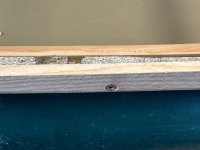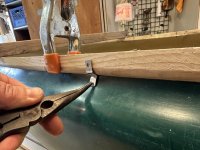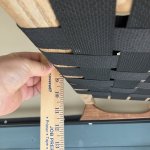-
Happy 1st Showing of a Color Photograph (1861)! 📷🎥🏳️🌈
You are using an out of date browser. It may not display this or other websites correctly.
You should upgrade or use an alternative browser.
You should upgrade or use an alternative browser.
Bell Wildfire RX (Yellowstone) Restomod
- Thread starter Pseudonym
- Start date
Bondo . . . . Maybe a teak boat deck caulking can that can sanded?
I have no idea whether Bondo or a caulk will adhere strongly enough to the edges of the Royalex to fill the tear-out gaps. If they will, it might be worth a try. I'm quite sure G/Flex would adhere if you "dam up" the inside and outside of the hull with walls of tape or something. Hardened G/Flex can be shaved and sanded. It will be an amber color unless you pigment it with green.
What about a thin (1/4") cap that could be placed on top of the gunwales and then shaped after application to blend in.
As long as water doesn't get trapped between the cap and the gunwales, which I suppose could eventually rot both, unseen.
I second what Glenn said about using g-flex if just trying to fill the voids. I haven’t thought about pigmenting it, but you could always experiment.I have no idea whether Bondo or a caulk will adhere strongly enough to the edges of the Royalex to fill the tear-out gaps. If they will, it might be worth a try. I'm quite sure G/Flex would adhere if you "dam up" the inside and outside of the hull with walls of tape or something. Hardened G/Flex can be shaved and sanded. It will be an amber color unless you pigment it with green.
As long as water doesn't get trapped between the cap and the gunwales, which I suppose could eventually rot both, unseen.
I'm really enjoying this thread. I've been through many of the same problems you're discussing, and it took so long to work everything out.Cleaning up the exposed Royalex edge:
I'd also be curious if anyone has secrets for finishing the exposed Royalex edge. It looks porous and dirty and just sort of bugs me. I also have tear-out in many places where the old gunwales had been screwed into place before. Those voids will be visible.
I've considered plunge routing a narrow dado slot to receive a filler piece of wood that I could epoxy into place but that seems like a lot of trouble and a recipe for permanently gluing the gunwales to the hull, making . I also don't relish trimming the top of the hull any lower and losing freeboard.
As ghastly as it might sound, I've considered Bondo too. It's color isn't so dissimilar to the Fir, so maybe it wouldn't be so bad? Not sure how it'll look with tongue oil applied.
Maybe a teak boat deck caulking can that can sanded? A clean black stripe in the middle might look crisp.
View attachment 140575
I have left the undersides of inwales square. It works great for mounting seats, thwarts and yokes. I recommend sanding the edge enough it doesn't hurt your fingers when you grab onto it quickly. Otherwise I'm not going to offer any woodworking advice, hopefully somebody who knows more than me will.
I respect that you don't like the appearance of royalex sandwiched between wood. The gaps where the screws were would bother me too. But I encourage you to try to accept it. I'm doubtful you'll find a sound and aesthetically pleasing way to deal with it. This canoe has a history already, and the scars to show for it.
I read some careful, well reasoned explanation of why double spaces were completely unacceptable, then why they should be banned.Sure you can complain. I also learned to double space at the end of sentences in high school typing class. However, I didn't know that the Xenforo software eliminates the double spaces. I'm using double spaces in this reply. If they are eliminated, I'm not aware of any any way for me to change that. One reason why double spaces may generally be unwanted is that each space is, I'm pretty sure, counted as a character and every message here is limited to 15,000 characters (which I can adjust). Allowing more spaces would disallow an equal number of letters, numbers and punctuation marks toward the message character limit.
I don't care. Single spaces are harder for me to read. Even uncomfortable with some fonts. It's as bad as someone typing everything in bold. I would be shocked if I'm the only one who perceives it this way.
Single spaces are harder for me to read. Even uncomfortable with some fonts. It's as bad as someone typing everything in bold. I would be shocked if I'm the only one who perceives it this way.
This issue is off topic but I'll make some comments. First, I don't think you'll find double spaces after sentences in many, if any, internet writings including the NY Times.
Second, I agree single spaces after sentences are harder to read.
Third, that's why a lot of internet writers only write in one sentence paragraphs.
Finally, I personally don't go as far as using only one sentence paragraphs. However, for readability and eye fatigue reasons, I believe internet paragraphs should usually have no more than five sentences, although I sometimes violate that rule.
Inadvertently.
Well @MrPoling and @Glenn MacGrady, as they say, "great minds... Also Glenn, please know that my "complaint" was all in jest and good fun. Hopefully my poor attempt at humor still came off ok despite the single spaced sentences.
Thank you, @MrPoling! I'm enjoying it too and starting to sort out my processes. I've made some progress amongst the margins of my work week, so my gunwales are now all fitted, planed flush and the inwale topsides have been re-routed in place.I'm really enjoying this thread. I've been through many of the same problems you're discussing, and it took so long to work everything out.
If I had to do it all over again, I would mill up the inwales and outwales square, then apply just an underside round-over on the outwale only before installation (because it needs to nest against the tumblehome, see below) and then varnish the inside face of both pieces before installation, where those surfaces will meet with the hull. That way I'd never have to take them off again after the initial fitting. As it stands, I have no preservative inside those faces and need to pull them off to apply tongue oil before replacing them.
It turns out that it's very easy to plane and rout the topsides of the gunwale and hull edge in place if you set up for it. I outfitted both my power planer and router with an outrigger, which made it very easy. Here was my first test:
I stabilized the canoe thereafter and improved upon the technique somewhat, but it was very forgiving, even wobbling around as seen in the clip above.
I built a similar sled/outrigger for the router. I used it to round-over the topside of the inwale with an 1/2" (or so) round-over bit. That roundover should feel quite nice on the outside of my shin/lower leg, when I'm heeled over and sitting. At least much more so than the vinyl/aluminum gunwales that I'm used to with hard edges.
I did not use a round-over bit on the outwale topside, because I was worried that the router bit's guide bearing would dip into the depressions created by each of the screw heads visible in the outside surface of the outwale, and thereby create a corresponding a divot in the outwale's round-over profile above each screw head.
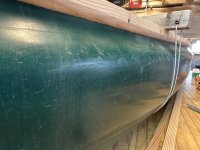
So instead, I just knocked off the edges with a hand plane . I'm very happy with it and it feels a little more organic than a perfectly rounded edge.
@MrPoling also convinced me to keep the entire length of the inwale bottom sides square, with a simple eased edge. No muss no fuss.
Attachments
Last edited:
As far as I know, all Royalex Mad River with wood gunwhales have the Royalex edge exposed. This photo is of a 1982 Explorer which we rescued two years ago. The foam was kind of degraded in spots, similar to what you described. It darkens from multiple coats of Watco Teak oil over time. My other Royalex Explorer, which I have owned since 1984, has much darker, and I think, more attractive exposed edges from over 40 applications of Watco. Yours will be a fun and truly unique craft. Good job! 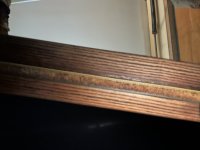
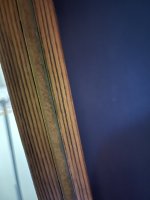


Thanks for the insight! That's encouraging because I'm still not quite happy about my exposed core, especially at those voids from the previous fasteners. The light planing did clean it up a little. I still haven't ruled out plunge routing a small recess along the top of the hull core to fill it with something better looking, but that will certainly have to wait until after this trip. I'm leaving in a week...As far as I know, all Royalex Mad River with wood gunwhales have the Royalex edge exposed. This photo is of a 1982 Explorer which we rescued two years ago. The foam was kind of degraded in spots, similar to what you described. It darkens from multiple coats of Watco Teak oil over time. My other Royalex Explorer, which I have owned since 1984, has much darker, and I think, more attractive exposed edges from over 40 applications of Watco. Yours will be a fun and truly unique craft. Good job!
Last edited:
I still have some sanding to do, but the final profile already feels very comfortable in the hand and I'm pleased with it. It ended up looking approximately like this:
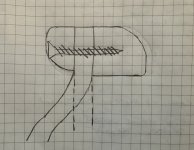
The prior-owner (@saltandsky), who gifted me this hull, was kind enough to detail the factory gunwales for me. So here is that profile for comparison:
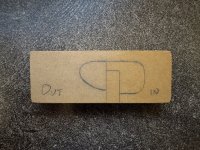
Their integral top cap over the hull edge is much more elegant.

The prior-owner (@saltandsky), who gifted me this hull, was kind enough to detail the factory gunwales for me. So here is that profile for comparison:

Their integral top cap over the hull edge is much more elegant.
Last edited:
Alan, this is a good suggestion. Unfortunately, due to my inexperienced muddling early on, I applied a round-over to one of the inwales before installation. Adding an extra strip on top of that curve would be hard to blend in nicely. So, if I add any wood strip to cover the hull edge, I'll first need to create a void (dado) in which to insert it, so that it can be sanded flush with the rest of the profile.What about a thin (1/4") cap that could be placed on top of the gunwales and then shaped after application to blend in.
Alan
Last edited:
On the subject of seat drops: this is my first solo and its as narrow a canoe as I have ever paddled. I haven't even gotten it wet, yet. I'm used to sitting in much bigger boats: Old Town Discos and Trippers. I'm comfortable kneeling but have really only ever done so for short stretches in whitewater. Right now, with the hull's beam pulled in to the width of the seat, the depth at that location is 12". I have a contoured seat (see above) which sits 10" above the bilge in its center. Initially, I'm thinking about drops that are 2" at the front edge of the seat and 1" at the back, hoping that I can accommodate kneeling and some sitting. That gives me a pitched seat in the 8-9" range. I'm 5'9" 170 pounds and do not have big feet.
I'd love any insight that folks might have. Maybe my Yellowstone compatriot @eckilson?
I'd love any insight that folks might have. Maybe my Yellowstone compatriot @eckilson?
Here is the 2"/1" seat drop on my Yellowstone Solo with vinyl gunwales. Seat ends up being 9.5" in the front and 10.5" in the back.On the subject of seat drops: this is my first solo and its as narrow a canoe as I have ever paddled. I haven't even gotten it wet, yet. I'm used to sitting in much bigger boats: Old Town Discos and Trippers. I'm comfortable kneeling but have really only ever done so for short stretches in whitewater. Right now, with the hull's beam pulled in to the width of the seat, the depth at that location is 12". I have a contoured seat (see above) which sits 10" above the bilge in its center. Initially, I'm thinking about drops that are 2" at the front edge of the seat and 1" at the back, hoping that I can accommodate kneeling and some sitting. That gives me a pitched seat in the 8-9" range. I'm 5'9" 170 pounds and do not have big feet.
I'd love any insight that folks might have. Maybe my Yellowstone compatriot @eckilson?
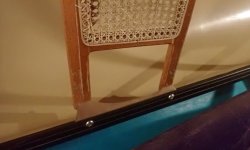
Here is the same view in my Wildfire with wood gunwales. Seat ends up being 9" in the front and 10" in the back.
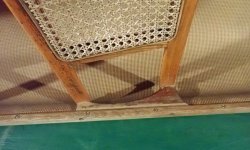
It is hard to make comparison measurements on my Yellowstone Solo since the vinyl gunwales hide the the royalex. Depth is at least 12". Width at the front edge of the seat is around 25"?
I have a straight seat, so your contoured seat will put you a little lower. At least with a straight seat that seat placement is great for kneeling, but can feel pretty twitchy when you are sitting. You have a high center of gravity, and the boat is 10' narrower than the Discos and Trippers that you are used to paddling. You will get use to it, probably even love it, but it will feel very different at fist, and you will probably need to kneel more often than you currently do.
While you are milling up your seat drops you might want to make an extra pair that are a little longer just in case. Bell also sold 4" drops, which to me are only good for sitting. If you have small feet and feel comfortable getting your feet out from under the seat you might feel more comfortable with something in the middle that will feel a little more stable when you are sitting. Or you might love the seat high, like I do. Just a thought...
Last edited:
I installed kneeling drops from Northstar in my Yellowstone Solo (it came with sitting drops), and they are 2”/1”, which puts the front edge of my seat 9” and the rear edge 10” from the floor of the canoe. Like @eckilson, I have a flat seat in mine.On the subject of seat drops: this is my first solo and its as narrow a canoe as I have ever paddled. I haven't even gotten it wet, yet. I'm used to sitting in much bigger boats: Old Town Discos and Trippers. I'm comfortable kneeling but have really only ever done so for short stretches in whitewater. Right now, with the hull's beam pulled in to the width of the seat, the depth at that location is 12". I have a contoured seat (see above) which sits 10" above the bilge in its center. Initially, I'm thinking about drops that are 2" at the front edge of the seat and 1" at the back, hoping that I can accommodate kneeling and some sitting. That gives me a pitched seat in the 8-9" range. I'm 5'9" 170 pounds and do not have big feet.
I'd love any insight that folks might have. Maybe my Yellowstone compatriot @eckilson?
My experience with the canoe’s stability with kneeling drops installed pretty much matches @eckilson’s: the height is nice for kneeling, but just a little twitchy for sitting (it kind of feels like sitting on a beach ball). I got used to the feeling pretty quickly, and I like to kneel, so I wouldn’t want to mount the seat much lower (worrying about foot entrapment). However, I’ve often thought that replacing my flat seat with a contour seat would make the canoe perfect: even that tiny difference in height would meaningfully improve its comfort for sitting, yet the seat would still be high enough to kneel comfortably (plus, a contour seat feels comfier than a flat one). I haven’t yet felt motivated enough to actually buy a contour seat to test that idea…but I’d be really curious to hear your impressions if you mount your seat with 2”/1” drops!
Also, FWIW: I find the Yellowstone Solo way more fun to paddle kneeling than sitting, so as long as you’re comfortable kneeling, my recommendation would be to mount the seat at a height that you like for kneeling and let the comfort for sitting fall where it may.
Attachments
Last edited:
I’ve often thought that replacing my flat seat with a contour seat would make the canoe perfect: even that tiny difference in height would meaningfully improve its comfort for sitting, yet the seat would still be high enough to kneel comfortably (plus, a contour seat feels comfier than a flat one).
Sorry, not a closeup of the seat drops, but this is my black-gold Bell Wildfire with a @Conk contour seat mounted under the factory solo kneeling drops, which, according to @Charlie Wilson, measure ⅝" at the back screw and 1¾" at the front screw.
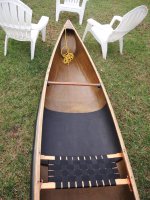
The vertical distance from the lowest point of the curved front rail of the seat to the kneeling pad is about 9"-9½". The Conk seat is much more comfortable than a flat seat for kneeling, not only because the front rail is curved but also because it is wide, rounded and gently sloped downward (unlike the Ed's curved seats). Because of this, the front rail of the Conk does not dig into the back of your butt or thigh like the sharp edge of a flat seat when kneeling.
The Conk seat is also comfortable to sit on and I'm stable sitting in my Wildfire. But you can't control a solo canoe in white or flat water nearly as well from a sitting position as from a kneeling position.
I'm 5'-9" with size 10+ shoes and don't have any issues with foot extraction with this setup—although, I should note, I almost always wear relatively low volume neoprene water shoes or boots.
@eckilson, @Sliding Focus and @Glenn MacGrady, you guys are great! Thank you so much for your insight.
I mounted the seat, thwarts and carry handles today for the first time and... my hull is now a canoe again. Everything still needs to be disassembled hereafter, so that I can oil parts and take care of loose ends, but I just may be able to get it out for a first test paddle tomorrow morning before disassembly. If I'm lucky.
Regarding the seat, I went ahead and made up some drops that are 2" at the front and 1" at the back. With my seat's contour, that yields a leading front seat edge that is 8" off the bilge and the rear of the seat is 9". On dry land, I can sit comfortably but it takes a little finagling to tuck my boot-clad feet under the seat. I wouldn't be worried about extraction, but I can't kneel on the ball of my foot with toes pointed forward. I must keep the topside of my foot pointed down to the bilge, with my toes pointed towards the stern. How do you guys position your feet?
Setting up a canoe this narrow, and a seat this low, is new to me, so I'm a little worried about getting sore over the course of a five day trip if I need to kneel most of the time. I will be loaded with gear, which should make the boat a little less twitchy while sitting at least.
I haven't refined the seat drop shape yet, but here's the rough draft. The seat has been wonderfully re-caned by my dear friend and I've got some fun photos to share of that process too.
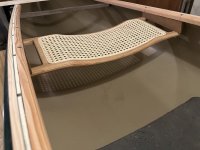
I mounted the seat, thwarts and carry handles today for the first time and... my hull is now a canoe again. Everything still needs to be disassembled hereafter, so that I can oil parts and take care of loose ends, but I just may be able to get it out for a first test paddle tomorrow morning before disassembly. If I'm lucky.
Regarding the seat, I went ahead and made up some drops that are 2" at the front and 1" at the back. With my seat's contour, that yields a leading front seat edge that is 8" off the bilge and the rear of the seat is 9". On dry land, I can sit comfortably but it takes a little finagling to tuck my boot-clad feet under the seat. I wouldn't be worried about extraction, but I can't kneel on the ball of my foot with toes pointed forward. I must keep the topside of my foot pointed down to the bilge, with my toes pointed towards the stern. How do you guys position your feet?
Setting up a canoe this narrow, and a seat this low, is new to me, so I'm a little worried about getting sore over the course of a five day trip if I need to kneel most of the time. I will be loaded with gear, which should make the boat a little less twitchy while sitting at least.
I haven't refined the seat drop shape yet, but here's the rough draft. The seat has been wonderfully re-caned by my dear friend and I've got some fun photos to share of that process too.

Last edited:
I must keep the topside of my foot pointed down to the bilge, with my toes pointed towards the stern. Is that how you guys position your feet?
When kneeling in a flat water canoe without toe blocks, absolutely yes. If you are not used to kneeling on the topsides (insteps) of your feet, or have inflexible feet and ankles, this may become uncomfortable or a foot may fall asleep. Then, it's time to extract your feet and sit on the seat for a while.
A really flexible paddler can kneel this way without a seat, resting the butt on the calves the way native paddlers did. To maintain foot and ankle flexibility, I used to watch TV from this "native position" on the floor during the off season in winter.
To keep the topside (instep) of your foot mostly flat on the floor, you also need paddling footwear with a flexible instep. That's a major reason I always use stretchy neoprene water shoes and boots. Leather boots, most running-type shoes and many sandals don't have enough instep flexibility to allow me to kneel in a low seat canoe. My whitewater canoe kneeling seats/saddles/pedestals are probably about 8½" off the floor.
Looks nice—it’s exciting to see this coming along, and I look forward to seeing the final results and hearing your impressions after your test paddle and your trip!Regarding the seat, I went ahead and made up some drops that are 2" at the front and 1" at the back. With my seat's contour, that yields a leading front seat edge that is 8" off the bilge and the rear of the seat is 9". On dry land, I can sit comfortably but it takes a little finagling to tuck my boot-clad feet under the seat. I wouldn't be worried about extraction, but I can't kneel on the ball of my foot with toes pointed forward. I must keep the topside of my foot pointed down at the bilge, with my toes pointed towards the stern. Is that how you guys position your feet? Setting up a canoe this narrow, and a seat this low, is new to me, so I'm a little worried about getting sore over the course of a five day trip if I need to kneel most of the time. I will be loaded with gear, which should make the boat a little less twitchy while sitting at least.
As for your question about kneeling: I alternate between the two positions you describe. I think I find myself with my feet flat/toes pointed toward the stern most of the time, but I definitely got a little sore from doing that until I bought a kneeling pad that I could fit my feet onto so that my ankles would be cushioned, rather than pressed against the hard bottom of the canoe (some kind of dedicated ankle cushion—e.g. a pool noodle?—would probably give the same benefit). When I want to put the balls of my feet on the floor, the seat can get in the way if I’m wearing water shoes; I solve that by taking my shoes off while I’m paddling (but NB: being shoeless could be a safety issue in a capsize—neoprene boots/shoes/socks like @Glenn MacGrady mentioned are a better idea).
You’re definitely right that adding a load will help alleviate any twitchiness you might feel. Also, “twitchy” is the most descriptive word I can think of, but it makes me picture a canoe that feels eager to dump you, and so I want to clarify that that’s not the Yellowstone Solo: even empty, it feels incredibly secure, but it always wants to roll around underneath you, rather than settle into one position like a flatter-bottomed canoe does. Loading it up with a few days’ worth of camping gear diminishes that feeling and lets you relax while sitting, even when the seat’s set up for kneeling.
Last edited:
Similar threads
- Replies
- 9
- Views
- 1K
- Replies
- 47
- Views
- 8K

